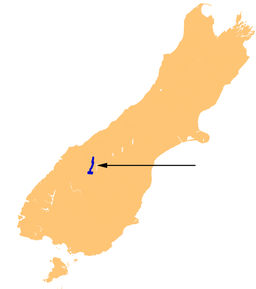Lake Wānaka
| Lake Wānaka | |
|---|---|
 Location on the South Island | |
| Location | Queenstown-Lakes District, Otago, South Island |
| Coordinates | 44°30′S 169°08′E / 44.500°S 169.133°E |
| Primary outflows | Clutha River |
| Basin countries | New Zealand |
| Max. length | 42 km |
| Max. width | 10 km |
| Surface area | 192 km² |
| Average depth | 300 m (estimated) |
| Surface elevation | 300 m |
| Islands | Harwich Island, Mou Tapu Island, Mou Waho Island, Ruby Island, Stevensons Island |
Lake Wanaka is located in the Otago region of New Zealand, at an altitude of 300 metres. Covering an area of 192 km2 (74 sq mi),[citation needed] it is New Zealand's fourth largest lake,[1] and estimated to be more than 300 m (980 ft) deep. Its name is Māori, a corruption of Oanaka ('The place of Anaka', a local tribal chief).[2]
Wanaka is a town on the lake with which it shares its name.
Geography
Geography
Lake Wanaka lies at the heart of the Otago Lakes in the lower South Island of New Zealand. The township is situated in a dramatic glacier carved basin on the shores of the lake and is the gateway to Mt Aspiring National Park. Wild and beautiful Lake Hawea is a 15 minute drive away, en route to the frontier town of Makarora, the last stop before the West Coast Glacier region. To the south is the historic Cardrona Valley, offering a scenic alpine route to neighbouring Queenstown. Otago Geography
Geology
At its greatest extent, which is roughly along a north-south axis, the lake is 42 kilometres long. Its widest point, at the southern end, is 10 kilometres. The lake's western shore is lined with high peaks rising to over 2000 metres above sea level. Along the eastern shore the land is also mountainous, but the peaks are somewhat lower.
Wanaka lies in a u-shaped valley formed by glacial erosion during the last ice age, more than 10,000 years ago. It is fed by the Matukituki- and Makarora Rivers, and is the source of the Clutha River. Nearby Lake Hawea lies in a parallel valley carved by a neighbouring glacier eight kilometres to the east. At their closest point (a rocky ridge called The Neck), the lakes are only 1,000 metres apart.[3]
Numerous small islands (notably Ruby Island, Stevensons Island and Harwich Island) are to be found at the southern end of the lake, with some now serving as ecological sanctuaries, for example for buff weka in case of Stevensons Island.[4] The only flat land around the lake is also to be found here, surrounding the outflow into the Clutha River. The towns of Wanaka and Albert Town are situated here.
Human history
Exploration and settlement
While Māori had long known of its existence, the first European to reach the lake is thought to have been Nathaniel Chalmers in 1853. Accompanied by Māoris, he walked from Tuturau (Southland) to the lake via the Kawarau River, later returning by a raft floating down the Clutha. Around 1859, other explorers who were now mapping the area also found a ruined Māori village (destroyed in a tribal raid in 1836) in the Makarora Valley. Around 1861, several new sheep stations had been established in around the south end of the lake, and in 1862, the lake itself was surveyed in a whaleboat.[2] The early European name was Lake Pembroke.[5]
Current use and tourism

In addition to ongoing sheep farming, the lake is now a popular resort, and is much used in the summer for fishing, boating and swimming. The nearby mountains and fast-flowing rivers allow for adventure tourism year-round, with jetboating and skiing facilities located nearby.
Lake Wanaka was repeatedly mentioned in the movie Mission Impossible III as a location the lead couple visited. It was the answer to Tom Cruise's question on the phone to verify the identity of his wife.
The cook and author Annabel Langbein owns a small estate at the side of the lake and filmed her latest series 'The Real Cook' here.
Conservation
As one of the few lakes in the South Island with an unmodified shoreline, the lake is protected by special legislation, namely the Lake Wanaka Preservation Act of 1973. This established a 'Guardians of Lake Wanaka' group, whose members are appointed by the Minister of Conservation, and advise on measures to protect the lake.[6]
Oxygen weed (Lagarosiphon major), an aquarium plant and invasive species native to Southern Africa, has been a problem in the lake's ecosystem for some time. Attempts to eradicate the weed have not been successful yet. Substantial suction dredging operations have shown promise, but tend to miss isolated spots which then regrow into larger weed beds.[7]
See also
References
- ^ Lake Wanaka (from the Tourism New Zealand website)
- ^ a b Wanaka, Lake (from Te Ara, The 1966 New Zealand Encyclopaedia)
- ^ Lakes: Laka Wanaka and Hawea (from the Tourism New Zealand website)
- ^ "What's Up DOC - Wanaka". Television New Zealand. Retrieved 13 October 2011.
- ^ NOTES. Otago Witness , Issue 953, 25 April 1889, Page 21 Christopher, fl 1868-1906 :SS Theodore on Lake Pembroke. 1885.
- ^ Briefing to the incoming Minister of Conservation 2011 - containing information about Statutory bodies, including the Guardians (from the Department of Conservation website, Friday 14 December 2012)
- ^ Template:PDFlink (NIWA report, June 2006, from the Land Information New Zealand website)

